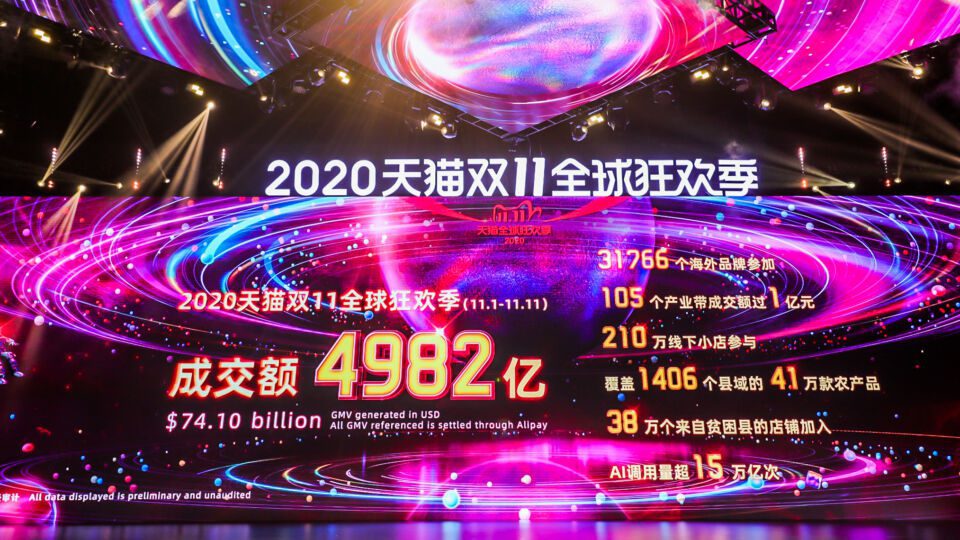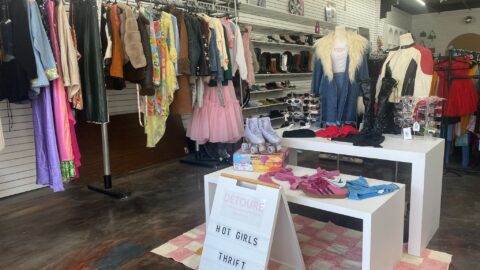November might seem far away, but the fact is, brands and retailers in China have already been preparing for the world’s biggest shopping event — known interchangeably as Singles’ Day, Double 11 or 11.11 — for months.
Last year, with the Chinese economy beginning to recover but travel still restricted, Alibaba extended the previously one-day event to 11 days. And while the date(s) of this year’s festival are yet to be announced, Nov. 11 will certainly be one of them.
What started as a purely Chinese phenomenon has increasingly become a global event, particularly as cross-border travel continues to be thwarted by the pandemic. During last year’s 11-day 11.11 bonanza, 31,000 of the 250,000 participating brands were non-Chinese, with the U.S. reigning as the top-selling country from overseas, according to CNBC. In fact, the U.S. accounted for $5 billion of Alibaba’s total $74.1 billion GMV during the festival.
That growing demand for U.S. products, combined with the sheer size of the Chinese market, make the potential hard to ignore: “It’s an opportunity for Western brands to find a faster-growing market than the one they’re currently operating in. One that will be, if it’s not already, the largest retail market in the world,” said Deborah Weinswig, CEO and Founder of Coresight Research in an interview with Retail TouchPoints.
Advertisement
There’s still time (although not much) for U.S. brands to be part of the 11.11 festivities, but those wishing to take part should keep a few things in mind:
- Some brands spend a large part of the year prepping for 11.11, and for many, the biggest test is another festival — 6.18;
- Merchants must account for the unique nature of this market with a China-specific strategy;
- While still relatively nascent in the U.S., livestreaming is critical to success during 11.11;
- U.S. brands can sometimes underestimate the scale of the event, and as a result underestimate how much and what kinds of inventory they need; and
- Festivals like 11.11 are only a jumping-off point; a year-round strategy is important to build a meaningful business in China.
[Editor’s Note: For a deeper look at the 11.11 opportunity for U.S. brands, check out the previous story in this series, which digs into the scale of the event and the nuances that make it so unique, and impactful.]
1. Test and Learn Before You Hit the Big Stage
Many brands, even 11.11 veterans, spend much of the year prepping for the world’s biggest shopping event. For a large number, the biggest test is another shopping festival — 6.18 (taking place, you guessed it, in June). This mid-year shopping festival tends to get minimal attention in the West amid the hoopla of Amazon Prime Day, but it is a huge event in its own right. To get a sense of the scale of this “smaller” festival, B2C ecommerce sales for this year’s 6.18 reached $83.81 billion — more than 7X the $11.19 billion in total online retail sales generated by this year’s Amazon Prime Day. “Small” is clearly a matter of perspective.
Perhaps even more important, however, 6.18 has become a testing and training ground for 11.11: “6.18 is a great opportunity for brands to launch new products or initiate new marketing campaigns to ramp up for Double 11,” said Tony Shan, Head of Tmall Global (Alibaba Group’s cross-border B2C marketplace) for the Americas region in an interview with Retail TouchPoints. “It’s a time for brands to test out different strategies and see what works, and also not have to place all their bets on Double 11, but instead spread out the sales and cash flow.”
Max Bissell, VP and General Manager of Hard Surface and Robotics at floorcare brand Bissell, which has participated in 11.11 for the past three years, echoed that sentiment: “6.18 for us is a setup for 11.11,” he said in an interview with Retail TouchPoints. “These festivals can really make or break your year, and your first time doing anything, it’s definitely not [yet] optimized. Whether you’re spending on site or with a KOL [key opinion leader], your share of voice is probably smaller and you’re probably paying a bit more than you would during a normal time period. We test and learn as much as possible leading up to the event and then lock in a plan and hang on for 11.11.”
6.18 isn’t the only “warm-up” period; brands also are increasingly using 9.9 and other smaller sales festivals to lay the groundwork for 11.11. Regardless, the important thing is to start — this isn’t the kind of project you can begin on Nov. 10.
“You can do this in a very short period of time and you don’t need to have a team on the ground, but you do need to have a trusted partner who can help you navigate,” said Weinswig. “There are certain steps that need to take place, whether that’s around marketing or payments or choosing a trade partner or your marketing partners. It’s somewhat formulaic, but every year there are a lot of changes. It’s important to do your research before you invest.”
2. Chinese Consumers are Unique, so your Strategy Should be Too
“The China market is very different than the U.S. Brands can’t just apply their U.S. strategy to China, because most likely that’s not going to work,” said Shan. “They definitely need to have a dedicated plan for China and have the right partners in place to help them execute their vision and strategy.”
Among the biggest differences is that Chinese commerce leans heavily toward mobile: for example, 90% of sales on Tmall Global are done via phones.
Another big difference is the weight Chinese consumers give to word-of-mouth recommendations: “Word-of-mouth marketing is huge in China,” said Shan. “Chinese consumers love to share what they’re buying, where they’re buying it and what they think. Ideally, you want them to like your product, because if they don’t, they will tell all their friends. The customer engagement and customer satisfaction piece is another aspect that brands need to take into consideration, because [Chinese consumers] are very vocal and they know how to spread the word.”
3. Livestreaming Buoys Consumer Confidence, Helps Build Buzz
This culture of vocal consumption and active engagement is a big reason why livestreaming has become so critical to success in China. While still relatively nascent in the U.S., livestreaming is mainstream in China, with eMarketer forecasting that livestreaming sales in the country will reach $131.5 billion in 2021, making up 37.4% of all social commerce sales this year.
“What has driven this exponential growth in Singles’ Day over the past few years has been livestreaming,” said Weinswig. “The return rates on product are in the single digits. Why? Because there’s a ton of information, there’s a ton of research that you can do, you’re talking to your friends, you can ask directly, ‘Is this a dull pink or a really hot pink?’ Because they’re asking and getting real live answers, we’re seeing this [type of] commerce move forward very fast, with a confident consumer.”
Bissell has seen this firsthand in campaigns he’s run with KOLs: “We’ve come up with a unique but impactful performance marketing model using key opinion leaders to help not only tell the brand story, but also demonstrate our products and create traffic and excitement during some of these big shopping festivals,” he said.
Brands don’t need to spend a lot of money to run a successful livestreaming campaign. By their very nature they are unscripted and aim at authenticity, not production value: “This should cost you $10,000 or less,” said Weinswig. “We’re seeing companies spend millions of dollars on production, but that’s just not what this is.”
4. Account for the Scale and ‘Flash Sale’ Vibe of 11.11 in your Assortment Planning
One thing that American companies often have difficulty accounting for is the sheer volume of sales during these major Chinese shopping events: “This is a timeframe specifically designed for explosive sales, so you need to prepare for it,” said Shan. You have to get inventory ready, you need to know what are the key items that you’re selling during this time. Make sure you have enough stock, the time to produce it and get it to where it needs to be for the sale.”
Additionally, part of what makes 11.11 special is the abundance of exclusive product offerings: “It’s limited time, limited quantity, limited offer,” said Weinswig. “That can be the product itself, or what we find to be really successful is special packaging — a special wrapping or you put three in a package, maybe it’s a mouthwash, toothbrush and toothpaste, and create a ‘Get Ready at Night’ bundle.”
Tactical is the way to go when selecting your 11.11 assortment, added Weinswig: “You really want to be narrow and deep on your assortment. Put a lot of science behind the products you’re choosing. So don’t develop product that hasn’t already been tested, or for which the data hasn’t been reviewed. You also need about 10 hero products that are just going to smash it. Selecting those 10 products is probably one of the most critical aspects.”
5. Plan for 11.11 — but also the Other 364 Days of the Year
While these Chinese shopping festivals garner much of the spotlight, the reality is that they are merely a medium-sized blip on the Chinese shopping calendar. Shan and his U.S.-based team work with brands year-round to get them up and running on Tmall Global. And while you can’t just set up a Tmall account like you can an Amazon one, the platform is no longer invite-only. In fact, Shan and his team have launched a program called Pitch Fest, specifically designed to fast-track the process of getting U.S. SMBs up and running in time for 11.11 (brands have until Aug. 6 to apply for this year’s program).
Both domestic and foreign brands need to look beyond 11.11, said Shan: “Brands do need to think about it comprehensively; you can’t place all your eggs in just the shopping festivals,” he said. “You need to think about what your year-round marketing and sales plan look like.”
According to Weinswig, no matter when you decide to enter the China market there is one crucial first step: “The absolute first thing you need to do is buy your name. If you’re even thinking about going to China, get your name or your brand in China. It sounds simple, but sometimes it’s not.”
Bottom line, China is a huge and growing opportunity for U.S. brands. In fact, if you ask Michael Evans, President of Alibaba, it’s becoming a necessity — after last year’s record-breaking 11.11 he told CNBC that “a China strategy and a digital strategy is going to be critical in the post-pandemic world.”









